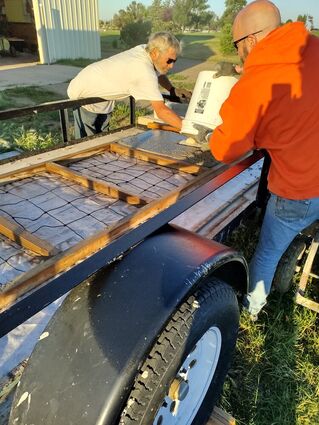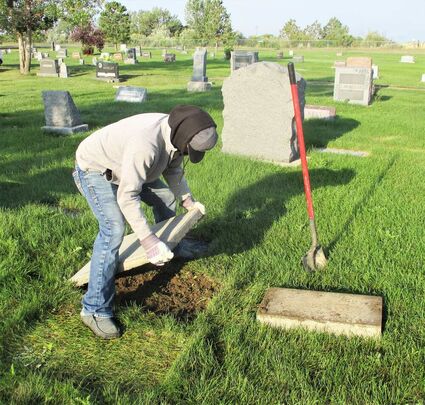Project to preserve veterans' headstones nears completion
September 1, 2021

Brian Friede, head caretaker at Kuper Cemetery, and Leve Jones, cemetery groundskeeper, pour cement mixture into molds to produce pads to be placed under veterans' headstones at both Kuper and Alice Nash Cemeteries. The 120 pound pads help stabilize the low profile headstones to keep them from sinking and being covered by encroaching soil and grass. Pads for about 180 headstones were made in this manner.
A project to stabilize headstones of veterans buried in Kuper Cemetery (northwest of Chinook) and Alice Nash Cemetery (south Blaine County) will soon be completed. The project involved making and installing concrete pads under the low-profile headstones provided to eligible veterans by the Veterans Administration (VA). Mick Thompson, Cemetery Board Chairman, said about 170 pads were made onsite and installed at the Kuper Cemetery and eight at the Alice Nash Cemetery. The project was directed and financed by the Blaine County Cemetery Board and carried out by employees of the board.
Thompson explained why the stabilizing work was necessary. He said, "Many of the veterans' headstones were barely legible because they were sinking in to the ground and grass was covering them." Pads were installed under about 30-40 headstones several years ago in what is referred to as the "military area" of Kuper Cemetery, an area reserved for veterans' burials. John Schneider, who was the Chinook High shop and ag teacher at that time pads were installed in the military area, said that work was completed about seven-eight years ago. All those graves were contiguous and in one area.
To stabilize the various individual graves outside the military area at Kuper and Alice Nash the remaining, randomly placed veterans' graves had to be located and identified. Brian Friede, head groundskeeper at Kuper, said, "It was a big project to find and mark the veterans' graves." He believes most were found but thinks there may still be a few that "will show up later that we missed in the initial survey." The grave sites at Kuper cover several acres.

Thompson said the project to make and install the pads began in the spring of 2021 and took a major commitment of resources to complete, both in material and labor costs, by the board. But the board agreed the project needed to be done. Each pad required two 60-pound bags of Sakrete (a preblended mixture of sand, coarse aggregate, and cementitious materials). Using a cement mixer to blend the material with water, the finished mix was then poured in to pre-made wooden forms and left to dry. The pad construction was done near the cemetery shop at Kuper Cemetery.
Mick Thompson said the materials cost about $3400. He added, "We hauled truckloads of materials and several pallets of cement mix." The crew created a work platform from a small trailer so they could pour and smooth the cement in the forms at waist level. The finished pads each weigh about 120 pounds. The dry weather helped speed the drying of the pads.
Once the pads were dry they were taken to the various sites where headstones needed to be placed on pads. Bryden Friede, a summer helper at the cemetery, demonstrated (see photos) how a headstone was lifted from its place and a slightly larger shallow hole was dug for the pad. After the pad was in place, the 100 pound headstone was set back on to the newly installed pad. (The headstones are provided to eligible veterans by the Veterans Administration. Daniel Dahl, with Wilderness Funeral Home in Chinook, said a funeral director could help a family determine if a veteran qualified for a headstone).

Cemetery groundskeeper Bryden Friede is shown placing one of the new cement pads that stabilizes veterans' headstones. The pad, slightly larger than the headstone, is laid into a shallow hole. The headstone, on the ground to the right in the photo, is then placed on the pad. The project to stabilize veterans' headstones at Kuper and Alice Nash Cemeteries is nearly completed. Work on the project started in the spring of 2021.
Mick Thompson said the project was nearly completed and went well. He added, "We see a lot of family plots with headstones that also need pads to stabilize them. Our cemetery operating rules do not allow us to do the stabilizing work for private head stones."

